MXA RACE TEST: THE REAL TEST OF THE 2022 YAMAHA YZ125
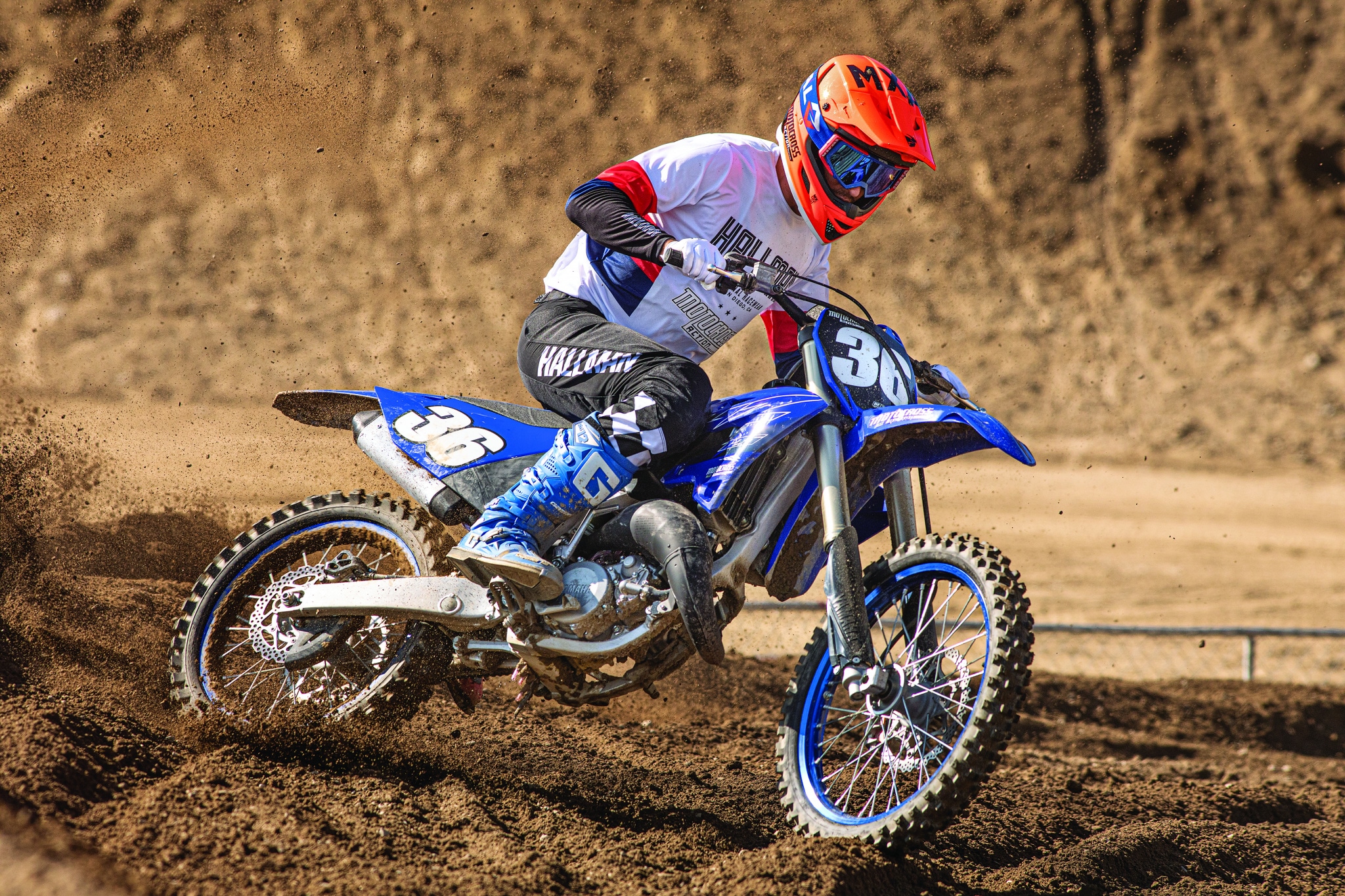 THE GEAR: Jersey: Thor MX Hallman Draft, Pants: Thor MX Hallman Differ, Helmet: Thor MX Reflex, Goggles: Viral Brand Factory Series, Boots: Gaerne SG12.
THE GEAR: Jersey: Thor MX Hallman Draft, Pants: Thor MX Hallman Differ, Helmet: Thor MX Reflex, Goggles: Viral Brand Factory Series, Boots: Gaerne SG12.
Q: FIRST AND FOREMOST, IS THE 2022 YAMAHA YZ125 BETTER THAN THE 2021 YZ125?
A: Yes. It is better, but we were surprised by the direction that Yamaha went. The new 2022 Yamaha YZ125 is faster than the 2021 YZ125 but not as fast as we expected. It gained midrange power but lost one of our favorite YZ125 attributes; its “easy to ride” engine character.
Q: IS THE 2022 YAMAHA YZ125 REALLY AN “ALL-NEW” MODEL?
A: Yes and no, which would logically mean no. Since the YZ125 has remained practically the same since 2006, the MXA test riders felt that it qualified as an all-new Yamaha because of the extensive list of updates. But, in truth, the chassis is almost the same as before. It still uses the same aluminum frame it got in 2005 with the same KYB shock, updated (but similar) SSS forks and the same triple clamps, swingarm, linkage, foot pegs and wheels, giving it a familiar feel on the track. Thankfully, the boys in blue made updates in the areas where loyal YZ125 owners asked for help. Here’s a list of the major changes.
(1) Engine. Nearly every functional part of the engine is new—the cylinder, cylinder head, port shapes, port timing, piston, piston pin, connecting rod, crankcase, crankshaft, flywheel, transmission, shift shaft, reed valve and power valve, as well as the pipe and silencer.
(2) Intake. The rear fender, side number plates, subframe, seat base and air filter cage have all been updated to flow more air into the engine.
(3) Carburetor. Gone is the 38mm Mikuni TMX carb, and in its place is a Keihin PWK-S38 PowerJet carburetor.
(4) Bodywork. Besides the front fender, front number plate and fork guards, all of the plastics have been updated. Plus, there is a new fuel tank, radiator louvers, seat and airbox.
(5) Brakes. The YZ125 adopted the brakes from the YZ250F and YZ450F models.
(6) Drivetrain. The 2022 YZ125 is fitted with Bridgestone Battlecross X20 tires, plus a new chain that is 73 grams lighter and a new 49-tooth rear sprocket that is 42 grams lighter.
Q: WHAT’S NEW INSIDE THE YZ125 ENGINE?
A: Although it has a new crankcase, cylinder and cylinder head, it’s hard to tell that the 2022 YZ125 engine is new from the outside; however, it is new inside and out.
The combustion chamber’s height has been increased by 1.6mm, the volume enlarged by 2.4 percent, and the compression ratio dropped from 8.57 to 8.20. The piston has a new skirt shape to match the ports, increased rigidity and a stronger piston pin. Dowel pins were added to the cylinder head to align it with the cylinder’s bore. The cylinder’s base is increased in size, and the front stud positions have been moved 3mm forward to make more room for a larger exhaust port and bigger, lower and wider transfer ports. The intake port is larger, and the YPVS (Yamaha Power Valve System) has an updated shape, lift and timing. The intake angle on the crankcase has been increased by 4 percent, and the crankcase is 8mm taller at the cylinder junction. The exhaust pipe has a narrower profile, and the silencer is 2 inches shorter. Last, there is an 8mm-longer connecting rod. In a two-pronged approach to beefing up the power, the rotational inertia of the crank has been increased by 2.70 percent, while the flywheel gets a 21-percent increase in rotational inertia to improve the mid- to high-rpm power.
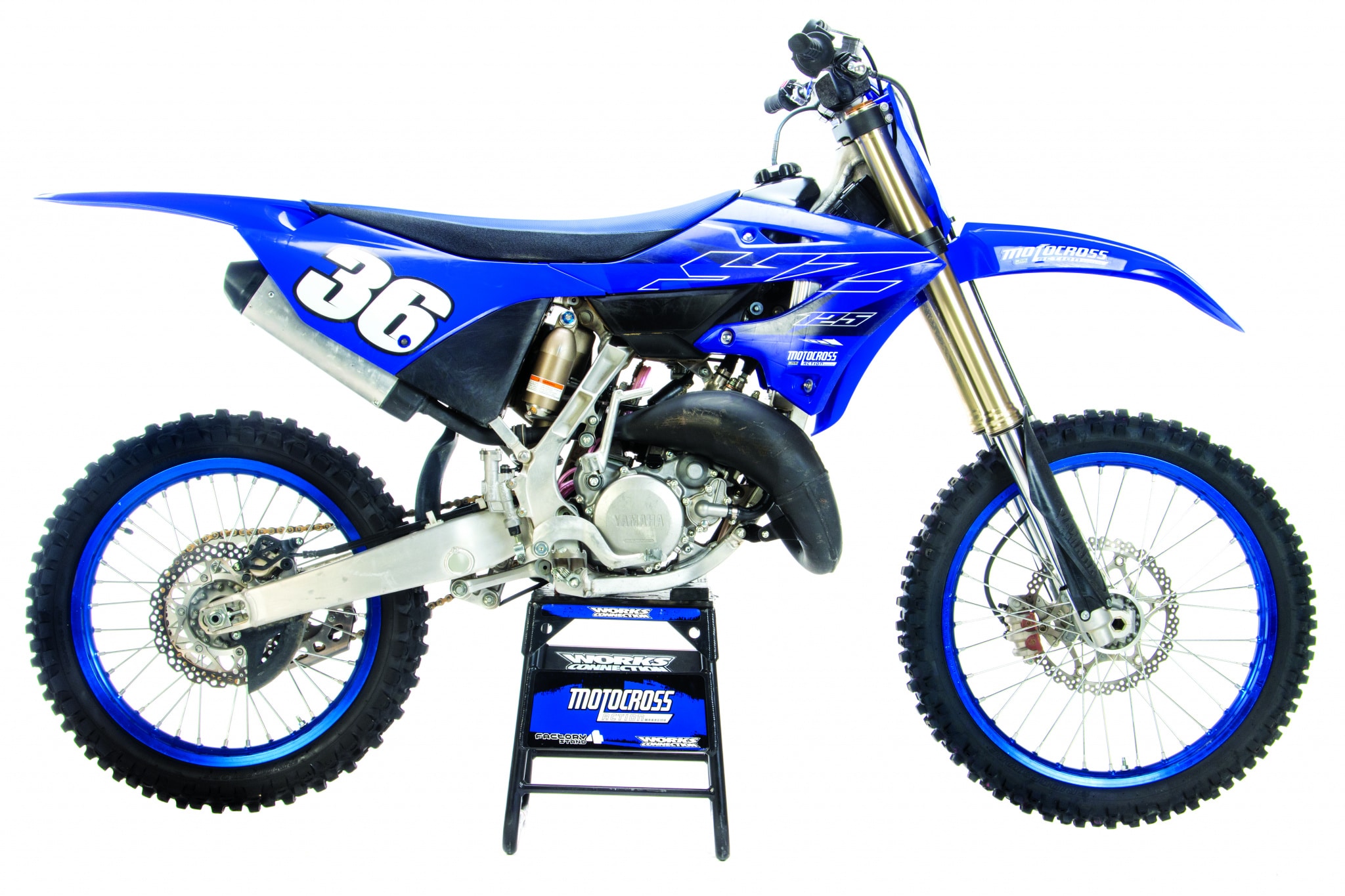 The 2022 Yamaha YZ125 is the first “new” 125 from Yamaha in 16 years.
The 2022 Yamaha YZ125 is the first “new” 125 from Yamaha in 16 years.
Q: HOW DOES THE 2022 YAMAHA YZ125 RUN ON THE DYNO?
A: The 2022 Yamaha YZ125 isn’t very impressive on the dyno. As usual, when a manufacturer is looking to improve one end of the power curve, power has to be sacrificed somewhere else. The 2022 YZ125 is slower than the 2021 YZ125 at the crack of the throttle, producing as much as 1-1/2 horsepower less than the 2021 YZ125 engine at 6500 rpm. The old bike was considerably better, both in the saddle and on the dyno, from off-idle to 7500 rpm, where the 2022 YZ125 starts to flex some muscle. The 2022 YZ125 stays above the 2021 power curve from 10,000 rpm to its 11,300 rpm peak. The 2022 YZ125 is considerably stronger than last year’s bike where it is ridden most, only losing out at the crack of the throttle. The peak horsepower of the 2022 YZ125 is 34.44-horsepower compared to the 2021 YZ125’s 33.38-horsepower on the same dyno on the same day.
To say that the MXA test riders were shocked to have waited 16 years for a new YZ125 engine, only to get 1.06 horsepower more, is an understatement. We expected a lot more—at the very least we expected an all-new Yamaha YZ125 to approach the 37.52 horsepower of a KTM 125SX. And, given that Yamaha had purchased two Pro Circuit-built Ryan Villopoto Replica YZ125 engines, we assumed that having the 38.32 horsepower engines in house would give them a worthy target to aspire to. It didn’t happen!
Q: HOW DOES THE 2022 YAMAHA YZ125 RUN ON THE TRACK?
A: In the dirt, the stock 2022 Yamaha YZ125 felt like a hopped-up 2021 model, and the track testing was confirmed by the dyno charts. The new bike is worse at low rpm, which makes it harder to ride because it doesn’t jump up on the pipe as quickly as the 2021 model. The 2021 YZ125 was easy to ride; it rolled from idle into the powerband seamlessly without any hiccups or bogs. The new YZ125 powerband isn’t anywhere as good off the bottom as the 2021, but it does come to life once you get into the midrange. Plus, it pulls harder until its peak at 11,300 rpm. It isn’t exactly a top-end engine like the KTM 125, but it’s better than it was last year at the end of the straights.
Yamaha gave up the bottom end grunt to gain speed and peak horsepower. Pros appreciate the new powerband the most. Intermediates are satisfied with it. Novices are partial to last year’s engine, and beginners have a much tougher time with the new bike. This is not the newbie engine it used to be.
Q: HOW IS THE STOCK GEARING?
A: The 2022 YZ125 received an updated transmission and an extra tooth on the rear sprocket, bringing it from a 13/48 to a 13/49 gear ratio. As for the transmission, the ratios have been optimized with a wider range from first to sixth. Plus, with 125 two-stroke riders getting faster and top Pros like Ryan Villopoto dropping down to race the YZ125 at two-stroke-only races more often, Yamaha decided to up the durability on the tranny as well, building wider gears and updating the shift forks and shift shaft.
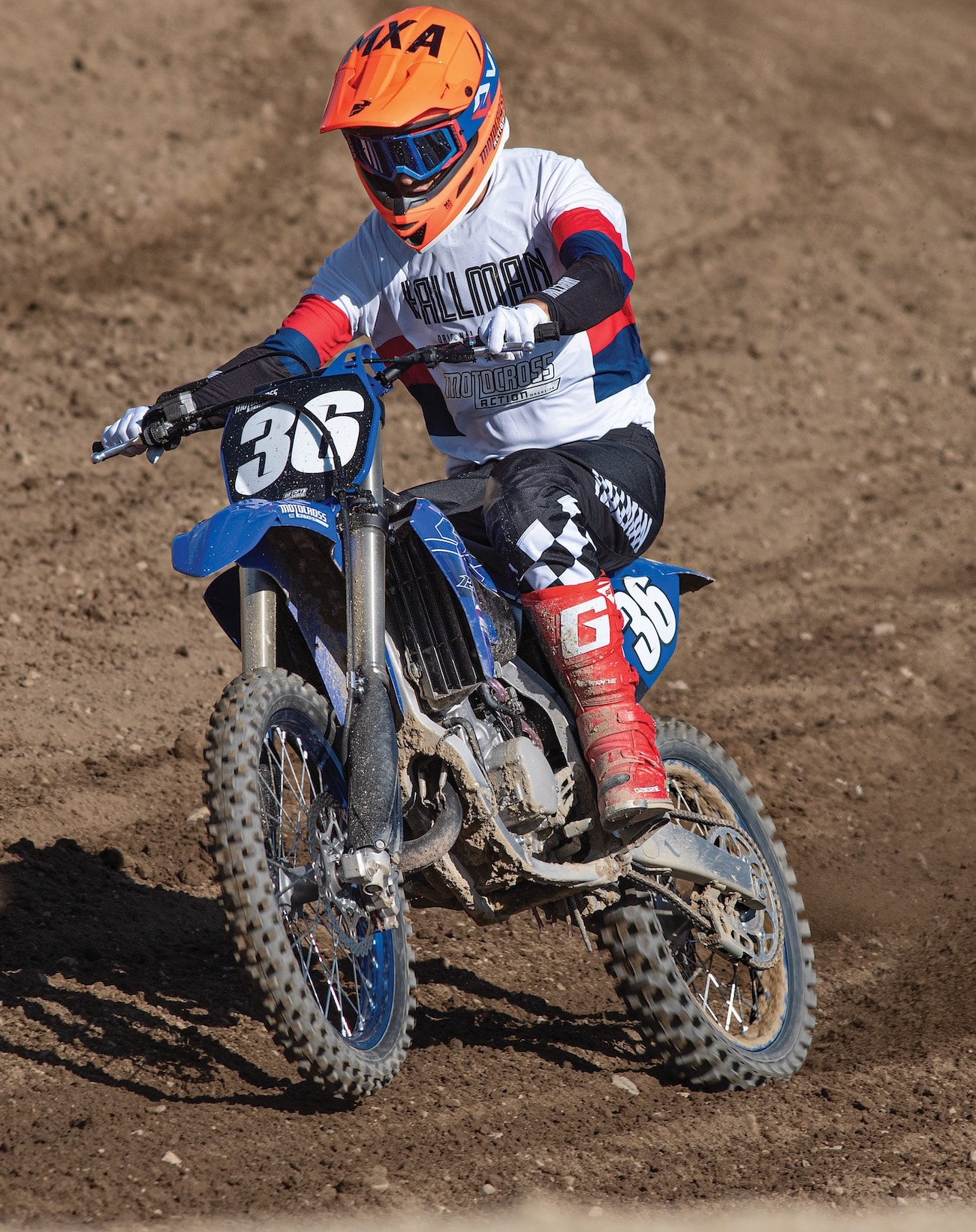 The new YZ125 is faster, stiffer and sleeker in 2022.
The new YZ125 is faster, stiffer and sleeker in 2022.
Q: HOW ARE THE ERGOS?
A: We like the feel of the 2022 YZ125’s rider triangle (footpeg-to-seat-to-handlebar geometry) better than before. It’s sleeker, flatter and narrower, but it’s definitely on the tall side. Yamaha claims that the new seat is 6mm lower in the front and 5mm taller in the middle, but the seat profile makes you sit on top of the bike rather than in it.
Q: HOW’S THE UPDATED YZ125 KAYABA SUSPENSION?
A: We’re glad to report that the YZ125 suspension didn’t take any steps backward, only sideways. Why are we so happy? Because we loved the YZ125 suspension before. Although last year’s forks will fit right into the 2022 YZ125 triple clamps (if you spent big money on them), the internal KYB SSS fork components on the 2022 YZ125 have been updated to share the same spring length and structure as the four-stroke line. The shock is the same as before.
Previously, the YZ125 came with a 4.2 N/mm spring in the forks and a 46 N/mm shock spring in the rear. It was great for the small and light demographic that rides 125s. Now, with a 4.3 N/mm spring in the forks and a 48 N/mm spring in the rear, the YZ125 suspension holds up better for heavier riders. Plus, the valving has also been made stiffer front and rear to increase hold up in braking bumps, making it better for faster riders—and, conversely, worse for the light and small demographic.
Our 155-pound test riders, who loved last year’s settings, thought that the new suspension setting was too stiff, but the new settings worked significantly better for our 175- to 190-pound test riders who were previously too big for the stock Yamaha YZ125. The suspension isn’t better or worse; it’s just tailored to a new audience now—a faster and heavier one.
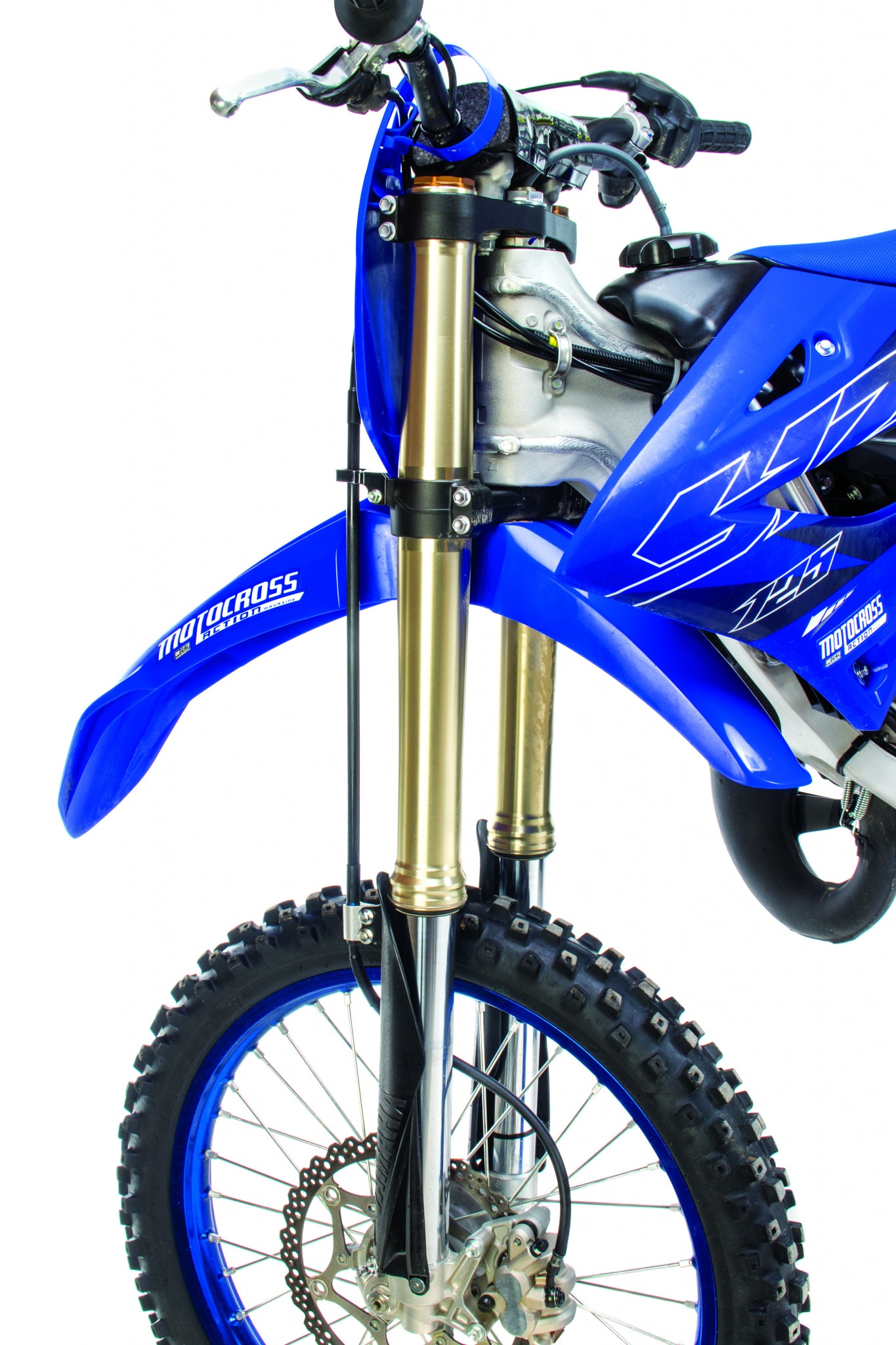 The KYB SSS fork’s stiffer springs and valving are from the four-stroke forks.
The KYB SSS fork’s stiffer springs and valving are from the four-stroke forks.
Q: WHAT MAKES 125 TWO-STROKES SO FUN TO RIDE?
A: In general, 125 two-strokes are the easiest bikes for manufacturers to “hit the mark” on with frame geometry and suspension settings. They handle great and inspire confidence for any rider who’s skilled with shifting and keeping the small-bore two-stroke in the meat of its power. Here are a few reasons why they’re so fun to ride.
(1) Speed. There is an old adage that says, “Slow bikes handle better than fast bikes.” It is true, because at slower speeds, the rider has more time to pick a smooth line and prepare for the upcoming corner or section.
(2) Weight. With 125s weighing significantly less than 250 two-strokes and all the four-strokes, bikes like the 202-pound YZ125 stay on top of bumps easier and don’t drive as much mass into acceleration and braking bumps. Plus, it’s easier to move around on the track to miss the big bumps when the bike is light.
(3) Rotating mass. With smaller pistons, lighter cranks, flywheels and clutches, 125 two-strokes have less rotating mass. Less rotating mass helps the bike stay leaned over in ruts easier, meaning you don’t have to fight against the rotational inertia as much.
Q: HOW DOES THE 2022 YAMAHA YZ125 HANDLE?
A: With the same aluminum frame, Kayaba shock and similar SSS forks as last year, the 2022 YZ125 feels very much like the 2021 model on the track. Our faster test riders, those in the 160- to 175-pound range, ran the sag at 100mm and left all of the suspension adjusters stock. For them, Yamaha hit the mark with suspension. Our lighter and slower riders went out on the compression clickers both front and rear. Additionally, they lightened up the shock’s high-speed compression and rebound adjusters. The 2022 YZ125 is still extremely comfortable and fun to ride. The only real complaint our testers had in the handling department was that our seat felt too tall coming into corners.
Q: HOW IS THE KEIHIN PWK38S CARBURETOR?
A: The Keihin PWK38S PowerJet carb is new to the YZ125 but not to Yamaha. The YZ250 has used the Keihin PWK 38S since 2001. Back in the heyday of two-strokes, the factory teams would use the PowerJet system often, because it’s known for delivering a crisp throttle response with improved over-rev capabilities. The PowerJet is electronically controlled and mapped with the CDI to provide additional fuel when the rpm is between 5000 and 9500 rpm (if throttle is more than half open). The PowerJet opens a separate fuel circuit that’s only used within these precise parameters to maximize power and avoid detonation. When it’s closed, the engine is only getting fuel from the main jet. Another plus to the Keihin PWK38S PowerJet-equipped carburetor is that it’s more tunable for engine builders because they can choose from a wide variety of PowerJet sizes.
However, most MXA test riders wanted to switch back to the last year’s Mikuni. Not only was it much crisper, as configured, but the power had a beter overall feel.
Q: IS THE 2022 YAMAHA YZ125 A KTM KILLER?
A: Ever since Honda, Kawasaki and Suzuki forfeited the 125 class and went four-stroke only, KTM and Yamaha have been in competition for two-stroke glory. In the blue versus orange battle, Yamaha had the upper hand for a while, but they began to lose steam when KTM passed them in horsepower and closed the gap on Yamaha in suspension performance. In 2021, the YZ125 came off the dyno 3-1/2 horsepower slower than the KTM 125SX. Thankfully, the 2022 YZ125 has improved its peak horsepower by one pony. Now, the YZ125 is 2-1/2 horses off the KTM. Off the start, the YZ125 can’t keep up with the KTM (or Husky or GasGas).
When it came time for lap time comparisons, we tested a stock Husky TC125 back-to-back with the new YZ125, and we were surprised by the results. Our Pro test riders logged faster lap times on the YZ125 than the Husky! How is that possible when the Yamaha makes less horsepower? Two main reasons: (1) Yamaha made improvements to the engine that boosted torque and power in the midrange. Our Pro testers could cover the YZ125’s bottom-end blemishes with corner speed and a quick left foot. (2) The stiffer suspension on the YZ125 is tailored more for fast Pro riders, while the stock Husky suspension comes with a 39 N/mm shock spring (compared to the YZ125’s 43 N/mm).
Q: WHAT DID WE HATE?
A: The hate list:
(1) Bottom end. We wish that Yamaha could have kept its easy-to-ride character that we knew and loved. Now, we have to clutch it more to get out of tight corners.
(2) Jetting. The jetting was very finicky for us. We made changes for our SoCal elevations, temperature and humidity. Don’t be surprised if you have to re-jet your 2022 YZ125 on day one.
(3) Wheels. We wish Yamaha would take a page out of KTM’s playbook on wheel spacers. KTM’s wheel spacers run on the bearings. This means that a KTM owner can swap wheels back and forth regardless of their axle size if they have the right size wheel spacers. If you are a longtime Yamaha owner, you know that the four-stroke rear wheels don’t fit on the two-strokes and vice versa.
(4) Seat height. The YZ125 seat pushed us too far forward coming into turns. Why would Yamaha want the YZ125 seat to be taller?
Q: WHAT DID WE LIKE?
A: The like list.
(1) Commitment. In a world dominated by four-strokes, with rumors of an electric future on the horizon, we were thrilled that Yamaha invested R&D money into the two-stroke lineup in 2022. We commend them.
(2) Suspension. We loved the Kayaba suspension before, and although it received significant changes, we still love it.
(3) Maintenance. The average mechanic can change a YZ125 top-end and still have money left over to afford entry fees.
(4) Weight. Although it gained a little weight over last year, it’s still lightweight compared to a four-stroke, just not a 192-pound KTM 125SX.
(5) Styling. With all-new bodywork, the YZ125 is one of the most beautiful bikes in the pits. Plus, it’s nice and slim at the radiators.
(6) Sound. The new pipe and shorter silencer make a beautiful noise. The stock YZ125 shorty silencer sounds a lot more like a shorty from FMF or Pro Circuit.
(7) Brakes. The YZ125 brakes now feature more rigid calipers, redesigned rotors and stronger brake pad material. Plus, the rear brake rotor was reduced from 245mm to 240mm, reducing unsprung weight.
(8) Seat. There is a move afoot to reinvent how seats are attached to the frame. Next year’s KTM has the seat bolt up by the gas cap. Honda moved its seat bolts to the front this year, and the Yamaha YZ125 has one 8mm bolt hidden by a plastic cap at the rear of the seat.
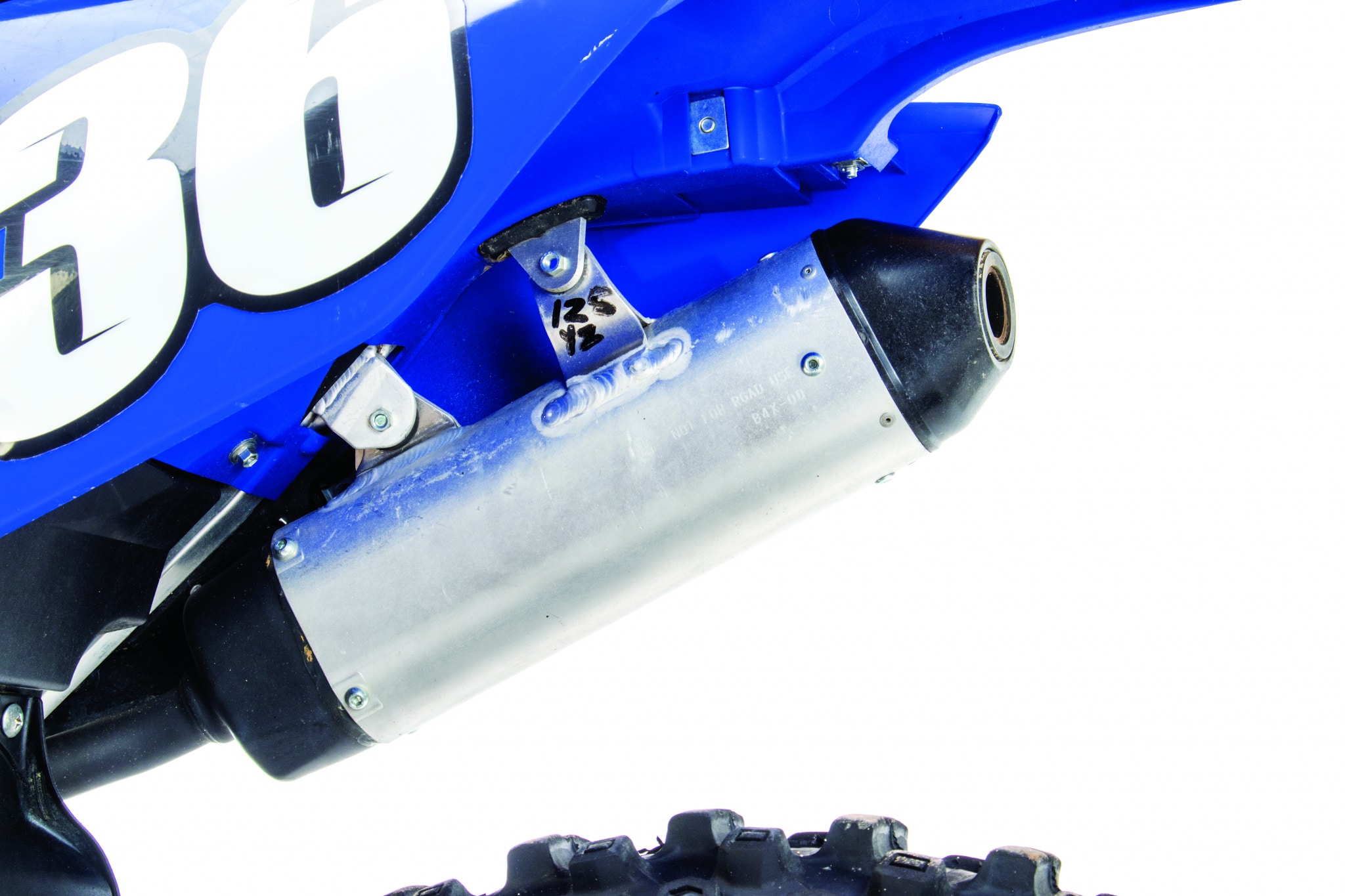 The stock silencer is 2 inches shorter, but it is still 17 inches long (and most aftermarket shorties are in the 10-inch range).
The stock silencer is 2 inches shorter, but it is still 17 inches long (and most aftermarket shorties are in the 10-inch range).
Q: WHAT DO WE REALLY THINK?
A: We used to say that the Yamaha YZ125 was more fun to ride and the KTM 125SX was more fun to race, because the KTM was lighter and faster, while the Yamaha allowed you to get into the meat of the power easier. The Yamaha always punished our test riders less whenever they made mistakes. Now, in search of more power, Yamaha has lost the bottom-end snap but gained power in the mid- and high-rpm ranges, along with more weight.
If you’re a Yamaha lover who has stayed away from the Austrian two-strokes in hopes of buying a better Yamaha YZ125, then this bike is for you. For $6899, the 2022 Yamaha YZ125 is $600 less than the KTM 125SX, and it offers the same great handling as the 2021 YZ125 because the frame geometry, swingarm and shock linkage all stayed the same.
MXA’S 2022 YAMAHA YZ125 SETUP SPECS
This is how we set up our 2022 Yamaha YZ125 for racing. We offer it as a guide to help you find your own sweet spot.
KAYABA SSS FORK SETTINGS
Yamaha’s target 125 riders used to be 150-pound amateurs advancing from minis to the big-bike category. Now, Yamaha is spec’ing stiffer spring rates and heavier valving to hold up better for bigger and faster riders who are most likely dropping down to the 125 for two-stroke-only races or to play ride. For hardcore racing, this is what we recommend on the 2022 Yamaha YZ125 (stock clickers are in parentheses):
Spring rate: 4.2 N/mm
Compression: 10 clicks out
Rebound: 11 clicks out
Fork-leg height: 5mm up
Notes: The forks were great for most adults over 160 pounds but too stiff for Novice and Vet riders. If you fit the second category, soften the forks by going out on the compression clickers and opening up the rebound clickers to encourage more oil flow through the valves.
KAYABA SHOCK SETTINGS
Like the fork, the KYB shock is plug-and-play for the new target audience. Our testers in the 160- to 175-pound range felt comfortable with the stock settings. For hardcore racing, we ran this setup on the 2022 Yamaha YZ125 (stock clickers are in parentheses):
Spring rate: 48 N/mm
Race sag: 100mm
Hi-compression: 1-1/2 turns out
Lo-compression: 12 clicks out
Rebound: 10 clicks out
Notes: The shock doesn’t do anything funny. It tracks straight and is in tune with the bike. We love this shock.
2022 YAMAHA YZ125 JETTING
After a long run with the 38mm Mikuni TMX carburetor, Yamaha spec’ed a Keihin PWK38S PowerJet carb on the 2022 YZ125. Since this is a first-year model, we expected Yamaha to have some jetting issues and they did. This is what we recommend for hardcore racing (stock settings are in parentheses).
Main jet: 162 (160)
Pilot jet: 72 (75)
Needle: NYDF
Clip: 1st line from top (2nd line from top)
Air screw: 3-1/2 turns out
Notes: After trying the leaner NYEF needle, we went to the stock needle (NYDF) in the first position. Yamaha includes two richer main jets—162 and 165. They also include two extra needles and a 72 pilot jet.



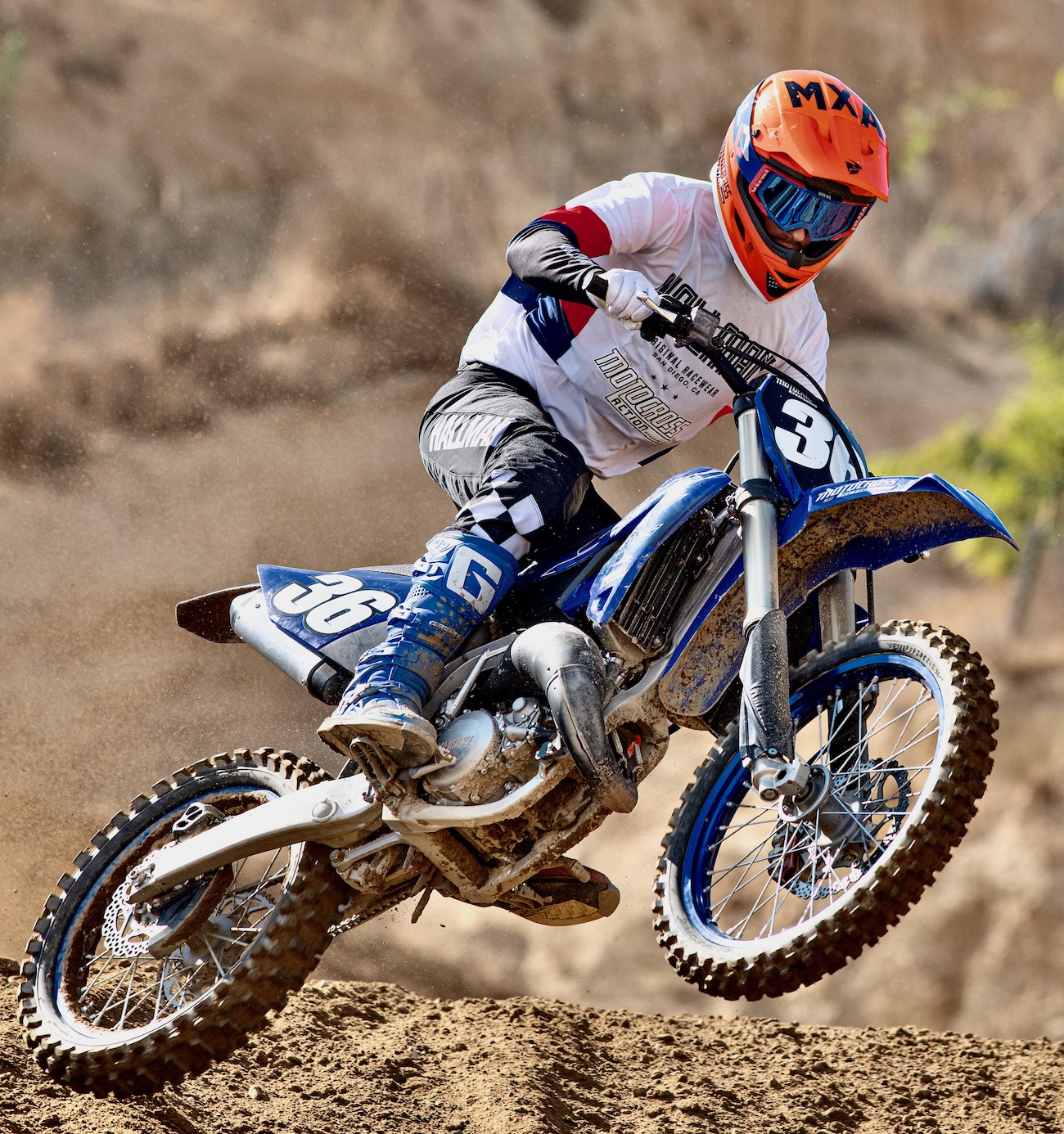
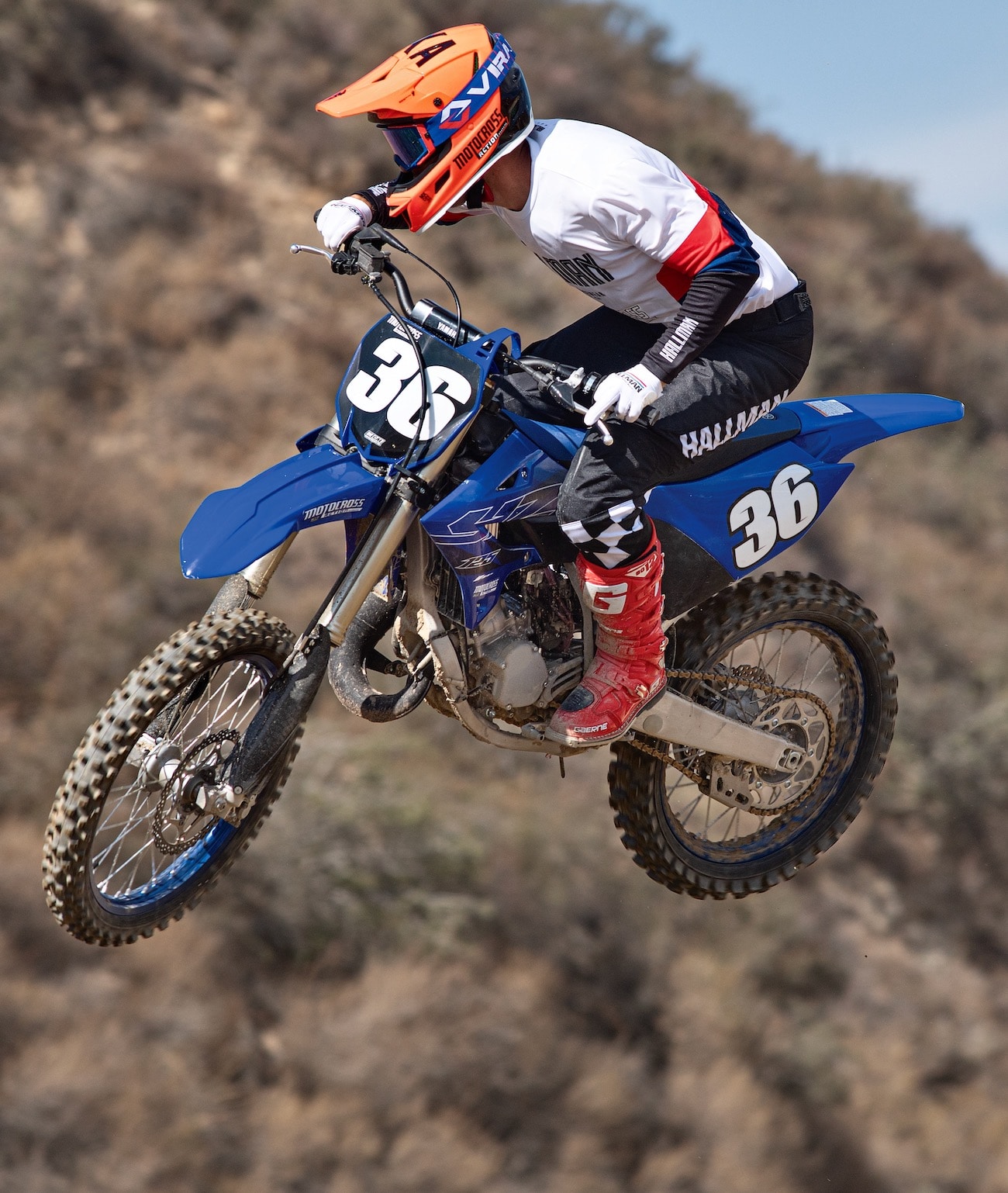


Comments are closed.